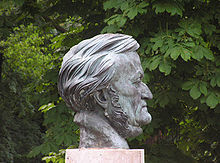Arno Breker
Arno Breker (19 July 1900 – 13 February 1991) was a German sculptor who is best known for his public works in Nazi Germany, where he was endorsed by the authorities as the antithesis of degenerate art.
[1] One of his better known statues is Die Partei, representing the spirit of the Nazi Party that flanked one side of the carriage entrance to Albert Speer's new Reich Chancellery.
At age 20 he entered the Düsseldorf Academy of Arts where he concentrated on sculpture, studying under Hubert Netzer and Wilhelm Kreis.
At this time Alfred Rosenberg, editor of the Nazi newspaper Völkischer Beobachter, actually denounced some of Breker's work as degenerate art.
Even Rosenberg later hailed his sculptures as expressions of the "mighty momentum and will power" ("Wucht und Willenhaftigkeit") of Nazi Germany.
The same year, Breker joined the Nazi Party and was made "official state sculptor" by Hitler, given a large property and provided a studio with forty-three assistants.
[6][1] Breker was on a list of 378 "Gottbegnadeten" (divinely gifted) artists exempted from wartime military duty by Hitler and chief propagandist Joseph Goebbels.
On closer inspection, though, the proportions of his figures, the highly colouristic treatment of his surfaces (the strong contrasts between dark and light accents), and the melodramatic tension of their musculatures perhaps invites comparison with the Italian Mannerist sculptors of the 16th century.
[1] Breker's rehabilitation led to backlash from anti-Nazi activists, including controversy in Paris when some of his works were exhibited at the Centre Georges Pompidou in 1981.
[citation needed] Breker's last major work was a monumental sculpture of Alexander the Great intended to be located in Greece.




